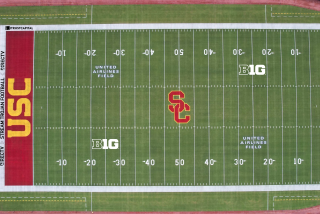UCSD May Get Own TV Station, Broadcast At-Home Education
- Share via
A new television station may soon activate its antenna on the campus of UC San Diego, allowing the La Jolla-based institution to expand its sphere of influence and possibly broadcast classroom lectures into the homes of San Diegans.
Administrators said Monday that educational shows are among the programming that UCSD hopes to air if awarded a Federal Communications Commission license to open the campus station, Channel 35.
“We have not yet obtained the license officially,” said Harold Ticho, vice chancellor for academic affairs. But he said UCSD was notified that it has won a lottery from among a pool of applicants vying for the channel.
Awaiting Formal Notification
“I believe we will be getting the license, but we are still waiting for a formal, written notification,” Ticho said.
Sherman George, director of the UCSD Media Center, would be responsible for overseeing the station’s technical operations. He said Channel 35 could be in operation within 18 months.
Ticho said that “the first inkling of trying to get a TV station was about five years ago. We have always been interested, and continue to be interested, in opportunities that provide us with a means for better outreach into the community.”
UCSD received considerable assistance in its license quest from multimillionaire and TV station owner Charles Woods of Woods Communications Group, Ticho said.
The media magnate, whose son attended UCSD, offered his expertise to help UCSD navigate the FCC bureaucracy. Woods, who owns five TV and three radio stations in several states, was also a real estate tycoon in San Diego: He once owned a block downtown that includes the Executive Hotel on First Avenue.
Although UCSD would be the first of the nine schools within the statewide UC system to operate a TV station, it would not be San Diego County’s first station operated by a university. Two other campuses, San Diego State University and United States International University, already have stations.
Focus on Its Own Programming
Unlike the SDSU station, which telecasts PBS programs, Channel 35 would air campus-produced shows, Ticho said.
“We would like to focus on broadcasting programs that originate at UCSD, that have a much more clearly educational tone,” he said. “It will not be a PBS station.”
Ticho said the university could offer a variety of programming.
“We often invite the public to musical performances at the university. . . . We have theater and other artistic activities. Now we can televise those events to people’s homes,” he said.
Also, Ticho said, the station could broadcast guest lectures and classes, such as adult continuing education courses.
“To give an example, we could broadcast a continuing education course in engineering,” he said. “It’s very difficult for someone to work all day and then go to a campus and take a course. Now that student can watch it at home, or maybe we’ll broadcast it to his place of work.”
Would Seek Grants, Donations
Registration fees for such courses could contribute to the station’s operating costs--an estimated $200,000 a year. Ticho said the university would seek grants and donations to finance the station.
According to George, the Media Center director, an additional $300,000 would be needed to purchase the station’s “hardware,” including an antenna and transmitter, which would be placed on campus-owned property atop Mt. Soledad. Once in operation, the station should have a range allowing it to send programs as far as Oceanside to the north, Escondido to the northeast and National City to the south, he said.
University officials emphasized the station’s non-competitive nature, saying the school has no intention of entering the ratings war.
Brad Warner, programming manager for KPBS, dismissed the notion that the new station would be unwelcome as a rival.
“What they can produce locally will be good for the community,” he said. “I wish them well.
‘Exciting, Difficult Job Ahead’
“Their operation is a low-power one and has a limited outreach,” he said. “It will only be able to cover a few miles instead of the entire marketplace. They have a specific mission and really are not competing with us. They have a long, exciting and very difficult job ahead of them.”
UCSD officials hope the station will give greater exposure to the campus.
“The station could offer courses for professional development or, frankly, of the semi-recreational type to people who are not registered students,” Ticho said. “We are also interested in reaching some of the minority groups--say--for example, some of the people from Southeast Asia who do not have better means of interacting with the university environment.
“This allows us to have better outreach into the community, maybe contact more of those people who otherwise don’t think about sending their children to a university,” he said.
More to Read
Sign up for Essential California
The most important California stories and recommendations in your inbox every morning.
You may occasionally receive promotional content from the Los Angeles Times.













